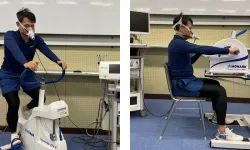(Press-News.org) CHAMPAIGN, Ill. — Scientists have found a way to boost ethanol production via yeast fermentation, a standard method for converting plant sugars into biofuels. Their approach, detailed in the journal Nature Communications, relies on careful timing and a tight division of labor among synthetic yeast strains to yield more ethanol per unit of plant sugars than previous approaches have achieved.
“We constructed an artificial microbial community consisting of two engineered yeast strains: a glucose specialist and a xylose specialist,” said Yong-Su Jin, a professor of food science and human nutrition at the University of Illinois Urbana-Champaign, who co-led the new research with U. of I. bioengineering professor Ting Lu. “We investigated how the timing of mixing the two yeast populations and the ratios in which the two populations were mixed affected the production of cellulosic ethanol.”
Postdoctoral researcher Jonghyeok Shin and Siqi Lao, a Ph.D. student in the Center for Biophysics and Quantitative Biology at the U. of I., carried out the work.
Glucose and xylose are the two most abundant sugars obtained from the breakdown of plant biomass such as agricultural wastes. The team was trying to overcome a common problem that occurs when using yeast to convert these plant sugars into ethanol. In the wild, the yeast strain of interest, Saccharomyces cerevisiae, prefers glucose and lacks the ability to metabolize xylose. Other scientists have used genetic engineering to alter the yeast so that it also consumes xylose, but these engineered strains still prefer glucose, reducing their overall efficiency in ethanol production.
Some scientists have pursued the idea that communities of microbes, each with its own special function, can operate more efficiently than a single, highly engineered strain.
“My group is dedicated to the design, analysis and engineering of synthetic microbial communities. Jin’s lab specializes in yeast metabolic engineering and biofuel production,” Lu said.
“Our complementary expertise enabled us to test whether a division-of-labor approach among yeast might work well in biofuels production.”
The researchers conducted a series of experiments testing the use of their two specialist yeast strains. They altered the order in which the different strains were added to the sugar mixture and the timing of each addition.
“We also investigated the ratios at which the two populations were mixed to determine their effects on the rapid and efficient production of cellulosic ethanol,” Jin said.
The team also developed a mathematical model that accurately predicts their yeasts’ performance and ethanol yields.
“We used the data from the experiments to train our mathematical model so that it captures the characteristic ecosystem behaviors,” Lu said. “The model was then used to predict optimal fermentation conditions, which were later validated by corresponding experiments.”
The researchers discovered that adding the xylose-fermenting yeast specialist to the mixture first, followed 14 to 29 hours later by the glucose specialist, dramatically boosted ethanol production, more than doubling the yield.
“This study demonstrates the functional potential of division of labor in bioprocessing and provides insight into the rational design of engineered ecosystems for various applications,” the authors wrote.
Yong-Su Jin and Ting Lu also are professors in the Biosystems Design theme in the Carl R. Woese Institute for Genomic Biology at the U. of I. Jonghyeok Shin is now a scientist at the Korea Research Institute of Bioscience and Biotechnology.
The Department of Energy and the Korea Research Institute of Bioscience and Biotechnology supported this research.
Editor’s notes:
To reach Yong-Su Jin, email ysjin@illinois.edu.
To reach Ting Lu, email luting@illinois.edu.
The paper “Compositional and temporal division of labor modulates mixed sugar fermentation by an engineered yeast consortium” is available online or from the U. of I. News Bureau.
DOI: 10.1038/s41467-024-45011-w
END
The restoration of mussel beds in the Wadden Sea or the Delta is a lot more successful when young mussels are helped a little with low, protective fences on the bottom. That is shown by research conducted by marine biologist Jildou Schotanus at the Hogeschool Zeeland / University of Applied Sciences in Vlissingen and at the Royal Netherlands Institute for Sea Research in Yerseke. She defends her thesis Restoring mussel beds on highly dynamic mudflats at the University of Groningen on Monday February 5th.
Ecosystem engineers
Mussels are so-called ecosystem ...
Although most patients diagnosed with Covid-19 will quickly recover, some people experience symptoms that linger well after they start testing negative again — including insomnia. Scientists already knew that insomnia was common in patients who had to be hospitalized, but a team of scientists led by Dr Huong T. X. Hoang of Phenikaa University, Vietnam began to wonder if mild infections might also affect sleep quality.
“As a sleep researcher, I received many questions and complaints from relatives, friends, ...
Hill Prize in Medicine Awarded to Martin M. Matzuk, M.D., Ph.D. (NAS), Baylor College of Medicine
Hill Prize in Engineering Awarded to Maria A. Croyle, Ph.D., The University of Texas at Austin
Hill Prize in Biological Sciences Awarded to Russell A. DeBose-Boyd, Ph.D. (NAS), UT Southwestern Medical Center
Hill Prize in Physical Sciences Awarded to Allan H. MacDonald, Ph.D. (NAS), The University of Texas at Austin
Hill Prize in Technology Awarded to Hermann Lebit, Ph.D., Alma Energy
February 5, 2024 – Austin – TAMEST ...
How can inclusivity be achieved in cardiopulmonary exercise tests for individuals facing lower limb injuries or disabilities that make it impossible to pedal a bicycle? Conventional exercise assessments rely primarily on lower limb exercise to determine maximal oxygen uptake – a cardiopulmonary function metric that indicates the maximum amount of oxygen that can be taken into the body in one minute. If lower limbs cannot be exercised, it necessitates an upper limb alternative. However, no clear upper limb ...
With more than 100,000 drug overdose deaths in the United States in one year, communities need more than ‘just say no’ drug prevention education and abstinence-only addiction treatment to save lives, an expert has warned.
Statistics show that most people who complete conventional drug prevention education as youth eventually go on to use alcohol, nicotine, or illegal drugs.
Harm reduction expert Sheila P. Vakharia, PhD, MSW, explains: “The majority have experimented, others use socially, and some experience substance-related problems or addictions. And, regardless of their patterns of use, most have never been taught strategies for safer substance use, ...
An article published in CMAJ (Canadian Medical Association Journal) describes five things clinicians and harm reduction workers should know about xylazine, a veterinary medication adulterating the illicit opioid supplyhttps://www.cmaj.ca/lookup/doi/10.1503/cmaj.231603.
There is no antidote to the effects of xylazine, and the authors explain that xylazine contamination should be suspected when naloxone appears not to work effectively in people with opioid toxicity.
Highlights:
Xylazine is not approved for use in humans and is increasingly found in illicit drug samples along with fentanyl. People using ...
Children and young adults with allergies or eczema who have difficulty swallowing may have eosinophilic esophagitis. A review published in CMAJ (Canadian Medical Association Journal) provides guidance on how to diagnose and manage this chronic inflammatory disease https://www.cmaj.ca/lookup/doi/10.1503/cmaj.230378.
In people with eosinophilic esophagitis, the esophageal lining is inflamed, which can cause injury and narrowing of the throat. Although it can affect anyone, the risk is higher in children aged 5–14 years ...
A recent re-emergence and outbreak of Mpox brought poxviruses back as a public health threat, underlining an important knowledge gap at their core. Now, a team of researchers from the Institute of Science and Technology Austria (ISTA) lifted the mysteries of poxviral core architecture by combining various cryo-electron microscopy techniques with molecular modeling. The findings, published in Nature Structural & Molecular Biology, could facilitate future research on therapeutics targeting the poxvirus core.
Variola virus, the most notorious poxvirus and one of the deadliest viruses to have ...
Research Highlights:
The weight loss medication tirzepatide significantly lowered the systolic blood pressure of nearly 500 adults who had obesity and took the medication for 36 weeks, or about eight months, in a subset of an international clinical trial.
Participants taking 5 mg of tirzepatide had an average systolic blood pressure reduction of 7.4 mm Hg; participants taking 10 mg had an average systolic blood pressure reduction of 10.6 mm Hg; and participants taking 15 mg had an average systolic blood pressure reduction of 8.0 mm Hg.
In this study, the blood-pressure lowering effects of tirzepatide were evident during both day and night ...
UNDER STRICT EMBARGO UNTIL 10AM (UK TIME) ON MONDAY 5 FEBRUARY 2024
Researchers from Queen Mary University of London have found that the molecule RvT4 enhances the body’s natural defences against atherosclerosis (hardening of the arteries) in patients with rheumatoid arthritis.
Studies in mice undertaken by researchers from Queen Mary University of London’s William Harvey Research Institute and Centre for Inflammation and Therapeutic Innovation, and funded by the European Research Council (ERC) and Barts Charity, shows that increasing levels of the RvT4 molecule in the body improves the ability of the body’s own defence ...






